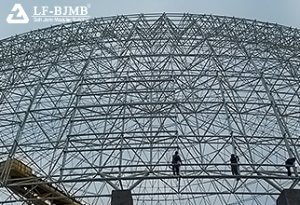+86 177 5193 6871
222, Block B, Diamond International, Guozhuang Road, Xuzhou, Jiangsu, China
In the short term to achieve carbon peak, is to gradually reduce carbon emissions. In the process, cost and many other constraints exist, reduce crude steel production is a more effective and direct way. 2021, the Ministry of Industry and Information Technology has repeatedly mentioned 2021 crude steel production strive to decline year-on-year, from high production to high-quality development; another way is to change the process, the blast furnace of tons of carbon emissions of steel in about 2.0 tons, electric arc furnace of tons of carbon emissions of steel in about 0.8 tons, so vigorously develop electric furnace steel-making can also help achieve the goal of carbon peak. Therefore, the development of electric furnace steel-making can also help to achieve the goal of carbon peak.

In terms of the construction sector, steel-framed buildings are a perfect fit for low carbon emissions and will help the steel industry to achieve peak carbon goals faster.
How the construction industry can contribute to peak carbon
As an important downstream of the steel industry, the construction industry consumes a huge amount of steel annually.In 2019, China digested 886 million tons of steel, of which 478 million tons were consumed by the construction industry. China is in a stage of rapid development, and the construction industry is still in a state of rapid expansion. If it is possible to make a reduction in the amount of steel used per unit of construction, the cumulative amount of steel used by the entire construction industry will be reduced substantially. Reduced demand will also force production to fall. As mentioned above, reducing crude steel production in the short term will be the most effective and direct way to reduce carbon emissions. So it is entirely feasible for the construction industry to help the steel industry achieve peak carbon by reducing steel use.
How can this be achieved? Steel-framed buildings may be the answer.
Steel Buildings vs Traditional Structures
Steel buildings have actually been developed for quite a long time. Marked by the first 55-story steel building in Chicago of the United States established in 1885 and the 320.7m Paris Tower constructed in France in 1889, the steel structure technology has been widely noticed and emphasized. At present, steel structure buildings in developed countries account for more than 30% of the total steel production, while China’s development is relatively late, the figure is only between 5-6%.
Steel-framed homes have several obvious advantages over traditional concrete-framed homes, and the advantages are particularly obvious in terms of helping carbon reach the peak. The table below compares some of the properties of a conventional home with a steel-framed home. Steel homes are stronger and have superior seismic and wind resistance. Also, because the components are pre-fabricated in a factory, on-site construction time is greatly reduced. It is also worth noting that because the strength of steel is significantly higher than that of concrete, the amount of steel, such as reinforcing steel, used in a steel building is significantly reduced for the same load conditions. The main reduction is in the weight of the main body of the structure, and according to a rough estimate, the main body weight (columns and beams) can be reduced by about 30%. This is one of the main advantages of steel buildings that can help the steel industry to achieve peak carbon.
In addition, steel structure buildings are also more environmentally friendly, with less dust and noise pollution on site due to the dry construction method. Under the current national background of promoting environmental protection, steel structure building will become the trend. The steel in steel structure buildings has a high recyclable ratio of 70-90%, and once it is built in large quantities, steel structure buildings will become “steel storage warehouses”. This will further help to reduce crude steel production and increase the proportion of steel made in electric furnaces, further contributing to the arrival of Peak Carbon.
Carbon peak will benefit the plate
At present in China, the proportion of steel structure buildings in new buildings is not very high. Steel structure buildings account for less than 7% of the entire construction industry, and the later goal is to increase to more than 15%. And most of them are public buildings, the proportion of residential is less than 1%. Later steel structure building is the development trend, the proportion will continue to increase!
The steel structure of the building for the application of sheet metal products more. Roofing and walls are made of lightweight color steel plates, and the main structure is made of medium-thick plates. In addition, the application of aluminum-zinc-plated sheet with better corrosion resistance is also increasing.
In order to achieve the goal of peak carbon in the steel industry in the future, the proportion of steel structure buildings will inevitably increase, and the application of plate products will also increase, which will help optimize the supply structure of the steel industry. Overall, the steel industry’s goal of reaching peak carbon is good for plate products.
